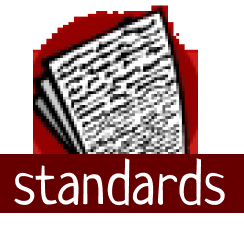|
|
There are eight workshops related to Funbook A. These workshops can be done without using the Funbook, but the Funbook pages enhance the workshop experience.
There are eight workshops related to Funbook A. For younger children you may want to do whole class lessons by going to Staples and enlarging the Funbook pages to use in front of the whole group. This is sometimes a better strategy for young children, especially if they lack small motor coordination needed for writing, cutting, coloring, or gluing. (These skills are sometimes needed for the Funbook pages.)
If you do whole group lessons using the enlarged pages, you will see that the workshops can indeed be done without using the Funbook. However, keep in mind that you may want to use the Funbook pages to enhance the workshop experience. You do NOT have to purchase Funbooks for each child. Instead, photocopy any Funbook pages you want to use, and distribute the punchouts and stickers from the student packets so that the children can each use their own manipulatives… during the lesson, or at home!
For each workshop listed below, read the workshop description. Check if the book is available on www.youtube.com, mostly so students can read it again at home. Refer to the downloadable workshop outline to get an overview of the workshop activities. Decide if there are any additional activities or topics that you would like to add to the basic workshop. You’re ready to go! Pre-read the book, gather your materials, and get ready to HAVE FUN WITH MATH!
|
|
 |
1. Beep Beep, Vroom Vroom! by Stuart J. Murphy
The book: Kevin’s little sister is not supposed to play with his car collection. He leaves them on |
a shelf in a special pattern so he can tell if she has touched them. What happens when Molly messes up the pattern?
The math activity: Punch out the cars on the cover of Funbook A. Sort and classify them by color (red-yellow-blue) or by type (cars-trucks-vans). Line them up in a pattern. Play a game that requires changing just one attribute.
Take-home item: The car punchouts and the “Traffic Jam” game board. For extra fun, take home a small toy car. |
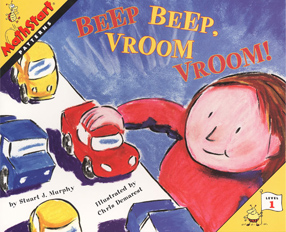 |
|
|
 |
2. Benny’s Pennies, by Pat Brisson
The book: Benny has five pennies and manages to buy something special for everyone in his family. |
The math activity: Retell the story using stickers from the Funbook. Play BANKO! and practice counting bunches of pennies, or nickels or dimes. Look at coins with a magnifying glass to see characteristics. Start a penny collection. Suggest making a coin collection with a penny, nickel, dime and quarter from the year you were born.
Take-home item: The story sheet for retelling the story. Five shiny pennies. A chart to start a penny collection.
|
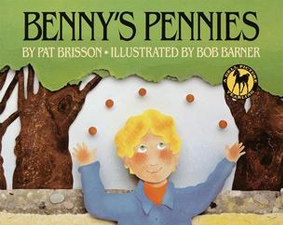
|
|
|
 |
3. Fiesta con Pizza, by Lawrence Schimel (a bilingual book)
The book: Model the story of the children making and cutting two different pizzas. One gets cut into eighths and the other into sixths. It’s hard to share the pizzas as different numbers of children arrive at the pizza party!
The math activity: Roll a die to play a game where children color 1,2,or 3 slices of a pizza. Build fraction vocabulary by using “eighths” or “sixths” to refer to the pieces as they get colored. Eg, if they roll a “3,” they color “3 eighths.”
Take-home item: A die (made from a wooden cube), and a copy of the game. (For extra fun, order pizza!) |
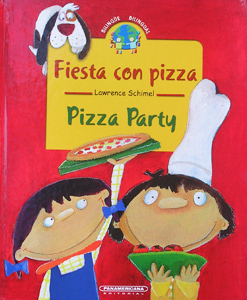
|
|
|
 |
4. Five Little Monkeys Jumping on the Bed, by Eileen Christelow
The book: The classic rhyme about the monkeys jumping on the bed, falling off and bumping |
their heads. The book has a twist, though. When the little monkeys go to bed, guess who starts jumping on the bed!
The math activity: Make stick puppets for modeling the poem. Put a quilt on the floor and have all the children jump and “fall off” one at a time, counting backwards as you play. Learn other rhymes for counting backwards.
Take-home item: The monkey stick puppets. Some apples and frogs, and a poetry sheet with two more poems on it. |
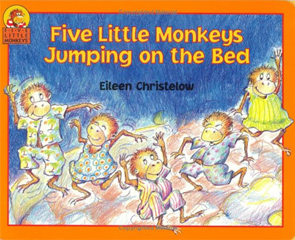
|
|
|
 |
5. Grandpa’s Quilt, by Betsy Maestro
The book: Grandpa loves his quilt, but it is too short and his feet get cold. What do the children do to help him?
The math activity: Model the story using large quilt squares. Have children copy quilt designs that are 3x3, or 4x4,; then have them make quilt designs of their own. Record sizes of invented quilts, like “4 by 5 = 20 squares in all.”
Take-home item: A small box of crayons and quilt designs to color, to make a “quilt sampler. |
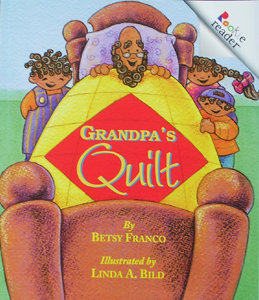
|
|
|
 |
6. One is a Snail, Ten is a Crab, by April Pulley Sayre and Jeff Sayre
The book: A snail has one foot, a person has two. An insect has six, and a crab has ten! |
By making different combinations of animals, children have fun practicing addition, counting by tens, and beginning place value!
The math activity: Play with animals to add up how many feet in all. See if children can select animals to make a given number. For example, 9 might be 2 dogs and a snail. Make crabs out of paper plates and count by tens.
Take-home item: The paper-plate crab, and a list of animal puzzles like “5 crabs + 1 bird = ?” (52!) |
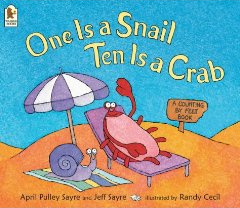
|
|
|
 |
7. Rooster’s Off to See the World, by Eric Carle
The book: Rooster wants to leave the barnyard and he takes some animal friends with him. When it gets dark, they all decide to go home. Each page has a picto-bar graph to represent the animals who are still part of the adventure.
The math activity: Color a barnyard. Move a rooster around the picture using position words like “under” the wheelbarrow, “in” the barn, “behind” the tractor. Add animal stickers to the picture. Then make a graph showing how many of each kind of animal is in your barnyard picture.
Take-home item: The barnyard picture and graph, and any unused stickers. |
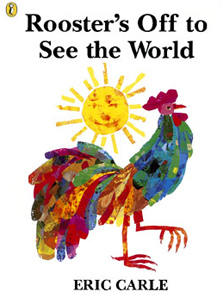
|
|
|
 |
8. What Comes in 2’s, 3’s and 4’s? by Suzanne Aker
The book: This is a book for very young children showing items that come in 2’s (like shoes, or eyes); 3’s (like knife-fork-spoon); or 4’s (like legs on a table).
The math activity: Before reading the book, have children brainstorm and generate lists of things that come in 2’s 3’s and 4’s. For older children go all the way to 12’s. If possible, |
keep the list in the classroom and add to it over the next few days. – After reading the book play “Concentration”, or “Memory” (where you find matching pairs), “TicTacToe” (to get three in a row) or “Dots” (where the goal is to make boxes with four sides.)
Take-home item: Concentration cards ( made with Funbook stickers), or a small deck of playing cards to find matching pairs. (Tell children to start by playing with just the red cards or the black cards, to make just 13 pairs.) |
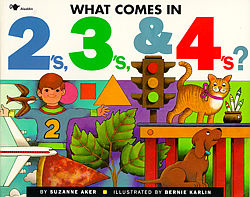
|
|
|
 |



